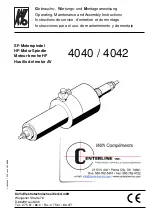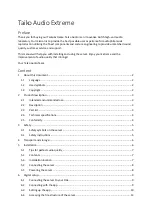
WavePro 700Zi
517
WP700Zi-OM-E-RevA
In the case of single-ended probes, the DC levels applied to the V+ probing pad are the same as the voltages that
appear at the appropriate grid locations on the scope screen. Differential probes are handled slightly differently.
In their case, the voltage applied to the V+ tip is the voltage specified in the Common mode voltage field, plus
half the voltage desired on the scope screen. The voltage applied to the V- tip is the common mode voltage
minus half the voltage desired. In this way, the probe experiences the specified common mode voltage, and the
differential voltage measured by the probe is calibrated for common mode voltage effects.
Differential and Single-ended Probe Basics
Differential and single-ended probe discussions are a sometimes confusing subject. There are aspects of
operation that must be known in order to understand their calibration.
A single-ended probe exposes a probing tip and a ground connection lead. Typically, the ground lead is
connected to the outer conductor in a coaxial cable, which is connected directly to the scope's ground. The
probing point is typically connected to the center conductor. Typically, the ground connection represents an
essentially zero-ohm connection to scope ground, and the probe tip is a specified impedance to that ground.
Other than probes, a 50-ohm cable is often used for single-ended measurements. In this case, the outer
conductor connects the scope's ground to the circuit's ground, and the cable is terminated with 50 ohms at the
scope, such that the conductor looks like 50 ohms looking into it at all frequencies.
In the case of single-ended measurements, the scope is measuring the difference between the probe tip and
ground. Since ground is considered to be zero volts, one can say that the voltage measured at the probe tip is
the absolute voltage.
A differential probe, in contrast, exposes two probing tips with an optional ground connection lead. Often, the
ground connection lead is left unconnected (more on this later). Each of the probe tips are connected to two
different signals in a circuit. The probe measures only the difference between the two probing points with no
actual notion of the absolute voltages present. In practice, differential probes have limitations not only on the
difference allowed between the two probing tips, but also the absolute voltage allowed. This absolute voltage is
referenced to the scope's ground. For this reason, the probe ground lead is sometimes connected to ground in
the circuit to make scope ground and circuit ground the same. This is often done only when the circuit is floating,
which means that the circuit's ground is free to move to any voltage, depending on its ground connections.
Despite the fact that the differential probe only measures the difference between the voltages at its probe tips, its
accuracy is sometimes affected by the absolute voltages present.
Differential signaling is used commonly for high-speed signals. In a differential system, two wires are used to
transmit the signal. Often the signals are the direct opposite of each other, with both swinging across zero volts.
Frequently, these signals have a common offset or bias applied to them. In this case, the common offset applied
to each signal is called the common mode signal component, and the difference between each signal is called the
differential mode signal component. Typically, the differential signal is the actual information signal being
transmitted, with the common mode signal being present for other physical reasons, such as the biasing of an
ECL gate. An ideal differential probe receives only the differential mode signal. Practical probes reject the
common mode signal to a large extent. The ability of a differential probe to reject the common mode signal is
stipulated by the common mode rejection ratio (CMRR).
Despite the fact that differential probes measure differentially, they can be used to measure common mode
signals. In this case, the V- tip is connected to ground, and the probe continues to measure the difference
between the tips. This is a useful configuration for identifying ground problems.
The voltages in differential systems can be described by the following diagram and equations:
Содержание DDA 7 Zi series
Страница 1: ...Operator s Manual WavePro SDA and DDA 7 Zi Series Oscilloscopes ...
Страница 2: ... L R R H HUD RU D D ...
Страница 41: ...Operator s Manual WP700Zi OM E RevA 40 The detachable WavePro Zi front panel ...
Страница 376: ...WavePro 7Zi 375 WP700Zi OM E RevA Absolute Offset Relative ...
Страница 439: ...Operator s Manual WP700Zi OM E RevA 438 ...
Страница 440: ...WavePro 7Zi 439 WP700Zi OM E RevA ...
Страница 544: ...Thank you for purchasing a WavePro SDA or DDA 7 Zi Oscilloscope ...
















































